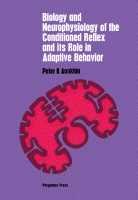Browse content
Table of contents
Actions for selected chapters
- Full text access
- Book chapterAbstract only
CHAPTER 1 - The Biological Roots of the Conditioned Reflex
Pages 1-24 - Book chapterAbstract only
CHAPTER 2 - The Nature of the Unconditioned Reflex
Pages 25-64 - Book chapterAbstract only
CHAPTER 3 - Systemogenesis as an Evolutionary Basis for the Development of Unconditioned Reflexes
Pages 65-105 - Book chapterAbstract only
CHAPTER 4 - Recent Theories on the Coupling of the Conditioned Reflex
Pages 106-125 - Book chapterAbstract only
CHAPTER 5 - The Hypothesis of the Convergent Coupling of the Conditioned Reflex
Pages 126-189 - Book chapterAbstract only
CHAPTER 6 - The Functional System as a Basis of the Physiological Architecture of the Behavioral Act
Pages 190-254 - Book chapterAbstract only
CHAPTER 7 - Conditioned (Internal) Inhibition: Statement of the Problem and Approaches to Its Solution
Pages 255-265 - Book chapterAbstract only
CHAPTER 8 - The Concepts of Sechenov, Vvedenskii, and Ukhtomskii Concerning the Origin of Inhibition in the Central Nervous System
Pages 266-271 - Book chapterAbstract only
CHAPTER 9 - Inhibition as a Function of the Organism as a Whole
Pages 272-280 - Book chapterAbstract only
CHAPTER 10 - Current Concepts Concerning the Nature of Inhibition
Pages 281-294 - Book chapterAbstract only
CHAPTER 11 - The Nature of the Interaction of Two Excitations in the Central Nervous System
Pages 295-312 - Book chapterAbstract only
CHAPTER 12 - The Mechanisms of the Origin of Conditioned Inhibition
Pages 313-329 - Book chapterAbstract only
CHAPTER 13 - The Physiological Characteristics of Biologically Positive and Biologically Negative Reactions of Animals
Pages 330-340 - Book chapterAbstract only
CHAPTER 14 - The Vegetative Components of the Conditioned Reflex as Indices of Interaction of Integrated Activities of the Organism
Pages 341-372 - Book chapterAbstract only
CHAPTER 15 - The Problem of the Localization of Internal Inhibition in the Cerebral Cortex
Pages 373-397 - Book chapterAbstract only
CHAPTER 16 - The Mechanisms of the Patterning of the Conditioned Reaction as an Integrated Activity of the Organism
Pages 398-424 - Book chapterAbstract only
CHAPTER 17 - The Inhibitory Effect of the Cerebral Cortex on Subcortical Activity
Pages 425-448 - Book chapterAbstract only
CHAPTER 18 - The Theory of the Dominant and Its Relation to Higher Nervous Activity
Pages 449-470 - Book chapterAbstract only
CHAPTER 19 - The Problem of the “Irradiation of Inhibition”
Pages 471-489 - Book chapterAbstract only
CHAPTER 20 - The Conflict Between Excitation and Inhibition and the Origin of Neurotic Conditions
Pages 490-502 - Book chapterAbstract only
CHAPTER 21 - Sleep and Sleeplike States
Pages 503-510 - Book chapterAbstract only
CHAPTER 22 - Certain Correlations in the Study of Conditioned Inhibition
Pages 511-517 - Book chapterNo access
Conclusion
Pages 518-532 - Book chapterNo access
Glossary of Pavlovian Terminology
Pages 533-534 - Book chapterNo access
Bibliography
Pages 535-568 - Book chapterNo access
Index
Pages 569-574
About the book
Description
International Series of Monographs in Cerebrovisceral and Behavioral Physiology and Conditioned Reflexes, Volume 3: Biology and Neurophysiology of the Conditioned Reflex and its Role in Adaptive Behavior focuses on the biological roots, characteristics, and nature of conditioned reflex and its function in adaptive behavior. The monograph first discusses the biological roots of the conditioned reflex. Concerns include sequential order of external influences and living protoplasm; anticipatory processes of protoplasm and the conditioned reflex; adaptive features of the conditioned reflex; and inborn signalization in higher animals. The book then takes a look at the nature of the unconditioned reflex, including biological nature of reinforcement; value of the temporal relationships of conditioned and unconditioned reflexes; and fixation of sequential order without the factor of reinforcement. The text describes systemogenesis as an evolutionary basis for the development of unconditioned reflexes; concepts concerning the nature of the coupling process; and hypothesis of the convergent coupling of the conditioned reflex. The book also examines functional system as a basis of the physiological architecture of behavioral acts. The monograph is a dependable source of data for readers interested in conditioned reflex and its function in adaptive behavior.
International Series of Monographs in Cerebrovisceral and Behavioral Physiology and Conditioned Reflexes, Volume 3: Biology and Neurophysiology of the Conditioned Reflex and its Role in Adaptive Behavior focuses on the biological roots, characteristics, and nature of conditioned reflex and its function in adaptive behavior. The monograph first discusses the biological roots of the conditioned reflex. Concerns include sequential order of external influences and living protoplasm; anticipatory processes of protoplasm and the conditioned reflex; adaptive features of the conditioned reflex; and inborn signalization in higher animals. The book then takes a look at the nature of the unconditioned reflex, including biological nature of reinforcement; value of the temporal relationships of conditioned and unconditioned reflexes; and fixation of sequential order without the factor of reinforcement. The text describes systemogenesis as an evolutionary basis for the development of unconditioned reflexes; concepts concerning the nature of the coupling process; and hypothesis of the convergent coupling of the conditioned reflex. The book also examines functional system as a basis of the physiological architecture of behavioral acts. The monograph is a dependable source of data for readers interested in conditioned reflex and its function in adaptive behavior.
Details
ISBN
978-0-08-021516-7
Language
English
Published
1974
Copyright
Copyright © 1974 Elsevier Inc. All rights reserved.
Imprint
Pergamon
